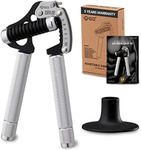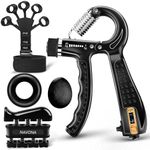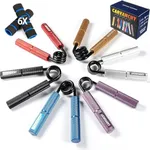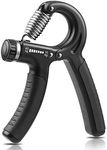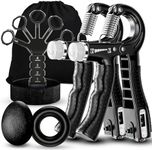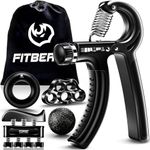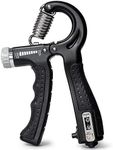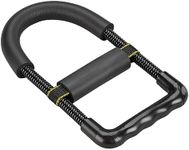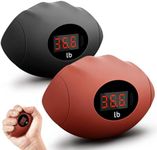Buying Guide for the Best Hand Grip Strengtheners
Hand grip strengtheners are excellent tools for improving hand strength, dexterity, and overall grip. They are commonly used by athletes, musicians, and individuals recovering from hand injuries. When choosing a hand grip strengthener, it's important to consider several key specifications to ensure you select the right one for your needs. Understanding these specifications will help you make an informed decision and get the most benefit from your purchase.Resistance LevelThe resistance level of a hand grip strengthener indicates how much force is required to squeeze it. This is important because it determines how challenging the exercise will be. Resistance levels can range from very light to very heavy. Beginners or those recovering from an injury should start with a lower resistance level (e.g., 10-50 lbs) to avoid strain. Intermediate users might opt for a medium resistance (e.g., 50-100 lbs), while advanced users or athletes may prefer a high resistance level (e.g., 100+ lbs) to provide a more intense workout. Choose a resistance level that matches your current strength and gradually increase as you build more strength.
AdjustabilityAdjustability refers to whether the resistance level of the hand grip strengthener can be changed. This is important for users who want a versatile tool that can grow with their strength. Adjustable hand grip strengtheners allow you to increase or decrease the resistance, making them suitable for a wide range of users and progression over time. If you are looking for a long-term investment or plan to share the device with others, an adjustable model is a great choice. If you prefer a simpler, more straightforward option, a fixed resistance model might be sufficient.
Grip MaterialThe material of the grip affects comfort and durability. Common materials include plastic, rubber, and foam. This is important because a comfortable grip can prevent hand fatigue and blisters during use. Rubber and foam grips tend to be more comfortable and provide better traction, which is helpful for longer sessions. Plastic grips are usually more durable but may not be as comfortable. Consider how often you will use the strengthener and for how long each session will last. If comfort is a priority, opt for rubber or foam grips. If durability is more important, plastic grips might be the better choice.
Size and ErgonomicsThe size and ergonomic design of a hand grip strengthener determine how well it fits in your hand and how comfortable it is to use. This is important because a poorly fitting strengthener can cause discomfort or even injury. Hand grip strengtheners come in various sizes and shapes to accommodate different hand sizes and preferences. If you have smaller hands, look for a compact model with a narrower grip. For larger hands, a bigger, more robust design might be more comfortable. Ergonomic designs that follow the natural shape of your hand can also enhance comfort and effectiveness.
PortabilityPortability refers to how easy it is to carry the hand grip strengthener with you. This is important for users who want to exercise on the go, such as during travel or at work. Compact and lightweight models are easier to transport and can be used anywhere, making it more convenient to stick to your exercise routine. If you plan to use the strengthener primarily at home, portability may be less of a concern. However, if you want the flexibility to use it in different locations, look for a model that is easy to carry and store.
